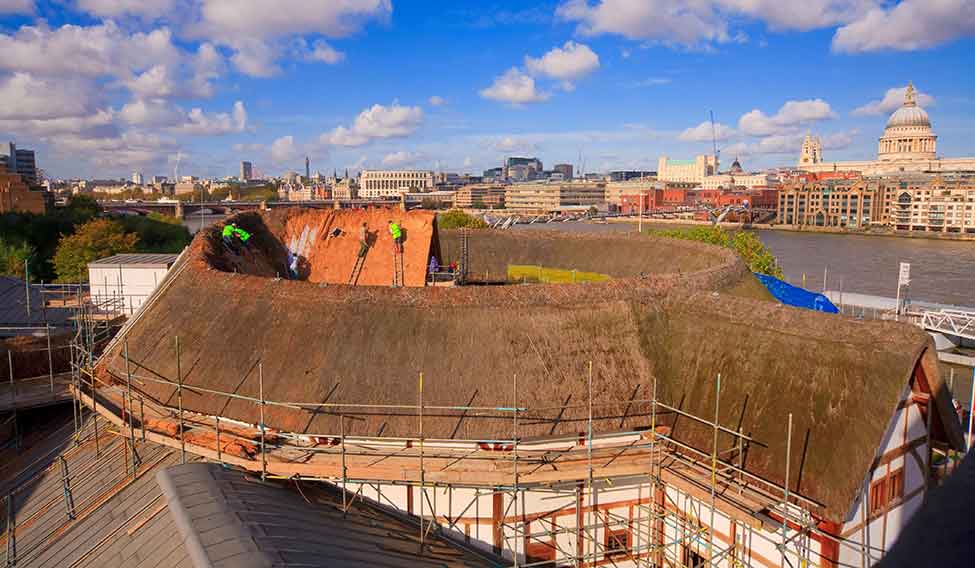Shakespeare's plays were written for the stage rather than for reading. So, it not surprising that the stage had a crucial role to play in his works and The Globe in London was where the playwright spent a major part of his professional life, earning both big bucks and a sterling reputation.
Today, there is also the Royal Shakespeare Company at Stratford-upon-Avon, but it is at Shakespeare’s Globe, which is located on the bank of the river Thames, overlooking St Paul’s Cathedral, that his plays are performed “authentically”, the way he had done it, back in his time, without microphones or lighting effects―only white light is used to recreate daylight.
The story of The Globe cannot be told without describing London of the 1600s, which was a growing industrial city with bustling suburbs that housed a large number of industries to the east. It was built in Southwark, south of the river Thames, where the city council had no control, and west of the London Bridge, at Bankside, where the working class, holding down jobs in manufacturing, would go seeking entertainment, which was aplenty.
 The galleries as seen from the stage.
The galleries as seen from the stage.
From animal-baiting rings, gambling houses, taverns and brothels, people were spoilt for choice. Then there were the playhouses―The Theatre, built by actor and entrepreneur James Burbage in 1576; The Curtain, which opened in 1577; The Rose, which came up a decade later in 1587, followed by The Swan in 1595 and The Globe in 1599―which added to the variety.
When Burbage decided to build The Globe, Shakespeare, along with four other actors, paid 10 pounds each to buy 10 per cent shares in it. Buying a stake gave the actors a say in the decision-making process. The remaining 50 per cent of the shares were held by Burbage, who provided material for the structure from the old theatre. And, thus The Globe came into existence.
In the first 14 years, it saw phenomenal success, with plays like Hamlet, Twelfth Night, Othello, King Lear and Macbeth gaining popularity. However, on June 29, 1613, during the performance of Shakespeare's new play All is True (now known by the name Henry VIII) a cannon misfired and lavnded on the theatre's thatched roof. Though no casualties were reported, the theatre was gutted.
However, it was rebuilt at the same place in a year's time. The second Globe had a bigger roof, a tiled one instead of the old thatched roof, over the stage. It had seats for 2,000 people and had space for 1,000 others to stand in the courtyard. The theatre did good business until 1643.
The credit for the popularity of Shakespeare's Globe today goes to American actor-director Sam Wanamaker, who during a visit to London in 1949, was astonished to see only a bronze plaque crediting Shakespeare for his contribution. Wanamaker devoted his life to reviving the old charm of The Globe. Along with an indoor theatre, an international education and research centre, and a permanent exhibition were set up.
The new Globe, contrary to common perception, isn’t round. It is actually a polygon with 20 sides. Built using unseasoned oak, the theatre boasts three entrances―the first Globe had only two. Then there is the large rectangular stage, which juts out into the audience. The stage is on three levels. If the floor of the stage, which you walk on, is terra-firma, the earth below is hell, inhabited by Jacobean demons, which can be accessed via a trapdoor. On the stage, are two fabulous marble columns (not real marble) called 'the Pillars of Hercules', which hold up a canopy roof, nicknamed 'The Heaven' where gods and angels dwell and it contains the signs of the zodiac. It has a centre balcony that is used for the balcony scenes in Romeo and Juliet. Shakespeare’s Globe is the only building in London that is allowed to have a thatched roof.
 The Globe's thatched roof.
The Globe's thatched roof.
Back in the day, aristocrats, lords and ladies came to the theatre, fashionably late, not to see the play, which they probably already had, but mostly to be seen. They could hire the Lord Rooms, considered the best seats not because of the great view of the stage it offered, but because of the visibility it provided to them.
There was also gallery seating where people would chat or play checkers and where women would sell their wares. The whole atmosphere was akin to a marketplace, buzzing with activity.
The theatres in those days had a peculiar way of announcing the start of a performance. A flag would be raised as a signal and thousands of people would rush in, dropping a penny or two, depending on their seat preference, into a box kept near the door. It gave rise to the term 'box office' because the money collected in the box was later taken to the office.
After all these years, there is a superstition that is strictly adhered to at Shakespeare’s Globe. Say the name Macbeth aloud inside the auditorium, and you would have to excuse yourself, go out and spit on the ground. Why? Because the name is supposed to bring bad luck. Apparently, actors have died and theatres have caught fire for not respecting the superstition.






